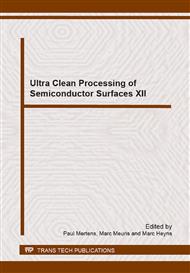p.111
p.115
p.119
p.125
p.128
p.131
p.134
p.138
p.143
Effect of Nozzle Distance and Fluid Flow Rate in Jet Spray Wafer Cleaning Process
Abstract:
Recently the reduction of the devise sizes causing the semiconductor processes more complicated and becoming more and more sensitive to the particle contamination [1]. Numerous studies have been carried out to improve the device yield with high particle removal efficiency (PRE) and Wet cleaning process along with megasonic is one of the well-established techniques used for particle removal in the semiconductor industry [1, 2]. However as the pattern size is reduced bellow 60 nm this method is not effective to improve the PRE. Recently, two-flow jet spray cleaning process became popular in semiconductor manufacturing processes due to its many advantages [2]. In this process, micron size water droplets are jetted onto a wafer surface at high velocity, which can remove the particles which are on the wafer surface. It consists of two separate nozzles for liquids and carrier gases which are concurrently delivered on the wafer surface during cleaning process. However, there is still lot of scope to improve the PRE during jet spray wet cleaning process by optimizing the process parametrs. Hence in the present study we focused on the jet spray wet cleaning parameters such as nozzle distance from the wafer and the flow rate of the carrier gas to improve the PRE with minimum pattern damage.
Info:
Periodical:
Pages:
128-130
Citation:
Online since:
September 2014
Authors:
Keywords:
Price:
Сopyright:
© 2015 Trans Tech Publications Ltd. All Rights Reserved
Share:
Citation:


